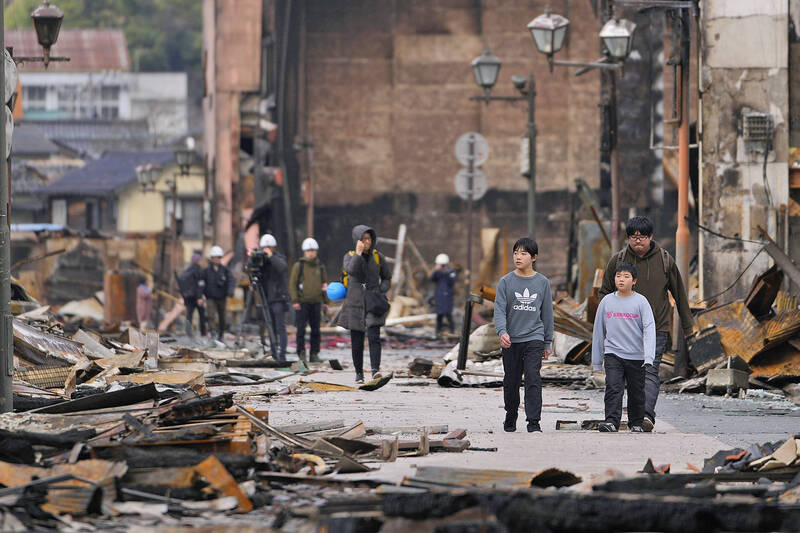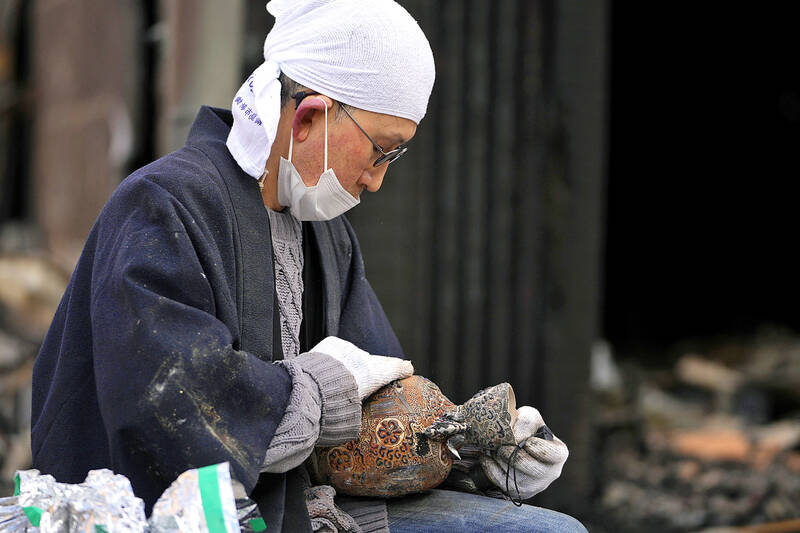There was an unfamiliar feel to the scenes that greeted residents and rescue workers in central Japan after sunrise on Tuesday. The previous afternoon, a 7.6 magnitude earthquake had jolted the region with violent shaking that went on for more than a minute, but must have felt like a lifetime to families relaxing in front of the TV on New Year’s Day.
Their screens, which had been airing variety shows to usher in the Year of the Dragon, quickly switched to TV announcers wearing hard hats, their voices filled with urgency as they implored people to head for higher ground as far away from the coast as possible. For the first time in almost 13 years, Japan was bracing for the arrival of a potentially deadly tsunami.
The waves did arrive, but they carried none of the destructive power of those that laid waste to Japan’s north-east coast on March 11, 2011, when more than 18,000 people perished, most of them by drowning.

Photo: AP
In towns and villages on the remote Noto peninsula, cars were perched on roads scarred by deep fissures, multi-story buildings rested awkwardly on their sides, and roof tiles carpeted collapsed homes. The destruction came not from a towering tsunami, but from a series of strong quakes, the first of which caused shaking that reached the highest level of seven on Japan’s seismic intensity scale.
This week’s disaster, in which 92 people have died and more than 460 have been injured — while 242 are still missing — was a reminder of Japan’s vulnerability to merciless seismic activity, and of the inadequate levels of disaster readiness in at-risk communities across the archipelago.
Skyscrapers with shock absorbers and pendulums, Japan has a deserved reputation for its earthquake-resistant construction technology. Located on the Pacific “ring of fire,” the country is the most seismically active in the world, experiencing about 1,500 noticeable quakes a year.

Photo: AP
Buildings constructed after 1981 are designed to withstand even powerful earthquakes. Finding oneself stuck on the upper floor of a swaying Tokyo skyscraper during a powerful quake can be deeply unsettling. But there is an expectation that the structure will remain upright, thanks to innovations including massive soft rubber cushions installed beneath the foundations, shock absorbers on each floor and, in some cases, enormous pendulums at the top to counteract the movement of the building.
But on Tuesday, the aftermath of the Noto disaster told a very different story. While coast guards checked the sea for people who may have been swept out by tsunami waves of up to 1.2 meters in height, rescue workers continued to retrieve bodies — and a small number of survivors — from the rubble.
The victims had died in a way Japan had not witnessed on this scale since January 1995, when a magnitude 6.9 quake sparked blazes that swept through neighborhoods in Kobe, a port city in western Japan, killing 6,000 people. For the first time in almost three decades, large numbers of people died in a way we have come to expect in other countries, but not in “earthquake-resilient” Japan.

Photo: AP
In terms of their ability to withstand powerful quakes, Monday’s disaster highlighted the yawning gap between isolated, depopulated communities such as Wajima and Suzu, where 78 people had been reported dead as of Friday, and cities such as Tokyo, 450km away.
ISOLATED AND AGING
Those differences are as much social as technological, according to Tsuyoshi Takada, professor emeritus at Tokyo University and president of the Japan Association for Earthquake Engineering.

Photo: AFP
“Many of the houses are more than 50 years old and are not maintained properly,” Takada said. “And the region is experiencing depopulation, like every rural area in Japan, with young people in particular leaving.”
In aging communities, evacuations from quake zones and approaching tsunami can take longer, often with tragic consequences. More than 56 percent of the victims of the 2011 triple disaster were aged 65 and over; in Noto, a large number of the dead and missing are older residents.
Many lived in homes that do not meet stringent design codes as they were built before 1981. Houses built before that year bore the brunt of the 1995 disaster in Kobe, leading to an overhaul in building codes requiring the seismic retrofitting of certain structures, including all public schools.
“The Noto earthquake’s intensity was strong enough to destroy houses and buildings, including many old timber houses vulnerable to strong shaking,” said Yoshiaki Nakano, director-general of the Earthquake Disaster Mitigation Research Division at the National Research Institute for Earth Science and Disaster Resilience near Tokyo.“Also, a series of earthquakes in the area in the past three years may have already damaged those buildings, which may have accelerated and increased the damage [caused on Monday].”
Older residents are less likely to invest in reinforcing their aging houses in their twilight years, according to Takuya Nishimura, a professor in the Disaster Prevention Research Institute at Kyoto University.
“It may be possible to add pillars to increase the strength of the house,” he said, adding that the heavy kawara clay roof tiles that appeared to “squash” homes in Wajima and Suzu could be replaced with lighter materials. “But it’s difficult for residents to carry out these reinforcements because of the cost,” he said.
Seismologists believe there is a 70 percent chance of a massive earthquake hitting the Tokyo metropolitan area within the next 30 years, killing up to 23,000 people and causing direct damage reaching ¥47 trillion (US$324 billion).
If that happens, it would be followed by an unflinching national sense of mission to quickly return Japan’s political and commercial center to something approaching normality.
But in rural, half-forgotten communities such as those on the Noto peninsula, the physical and economic scars will remain long after the rubble is removed. That was evident in Wajima this week among the smoldering remains of the 1,000-year-old Asaichi morning market, a center of community life that was mounting a tourist-driven recovery after three years of pandemic restrictions.
Kohei Kirimoto, whose family have run a traditional lacquerware business in the market for more than 200 years, chatted with friends amid the destruction as he put out food in the hope of attracting his missing cats.
“Our minds are blank right now,” he said. “But we need to burn this image into our memories … and then eventually start the recovery process. That’s all we can do.”

June 9 to June 15 A photo of two men riding trendy high-wheel Penny-Farthing bicycles past a Qing Dynasty gate aptly captures the essence of Taipei in 1897 — a newly colonized city on the cusp of great change. The Japanese began making significant modifications to the cityscape in 1899, tearing down Qing-era structures, widening boulevards and installing Western-style infrastructure and buildings. The photographer, Minosuke Imamura, only spent a year in Taiwan as a cartographer for the governor-general’s office, but he left behind a treasure trove of 130 images showing life at the onset of Japanese rule, spanning July 1897 to

One of the most important gripes that Taiwanese have about the Democratic Progressive Party (DPP) is that it has failed to deliver concretely on higher wages, housing prices and other bread-and-butter issues. The parallel complaint is that the DPP cares only about glamor issues, such as removing markers of Chinese Nationalist Party (KMT) colonialism by renaming them, or what the KMT codes as “de-Sinification.” Once again, as a critical election looms, the DPP is presenting evidence for that charge. The KMT was quick to jump on the recent proposal of the Ministry of the Interior (MOI) to rename roads that symbolize

On the evening of June 1, Control Yuan Secretary-General Lee Chun-yi (李俊俋) apologized and resigned in disgrace. His crime was instructing his driver to use a Control Yuan vehicle to transport his dog to a pet grooming salon. The Control Yuan is the government branch that investigates, audits and impeaches government officials for, among other things, misuse of government funds, so his misuse of a government vehicle was highly inappropriate. If this story were told to anyone living in the golden era of swaggering gangsters, flashy nouveau riche businessmen, and corrupt “black gold” politics of the 1980s and 1990s, they would have laughed.

In an interview posted online by United Daily News (UDN) on May 26, current Chinese Nationalist Party (KMT) Chairman Eric Chu (朱立倫) was asked about Taichung Mayor Lu Shiow-yen (盧秀燕) replacing him as party chair. Though not yet officially running, by the customs of Taiwan politics, Lu has been signalling she is both running for party chair and to be the party’s 2028 presidential candidate. She told an international media outlet that she was considering a run. She also gave a speech in Keelung on national priorities and foreign affairs. For details, see the May 23 edition of this column,